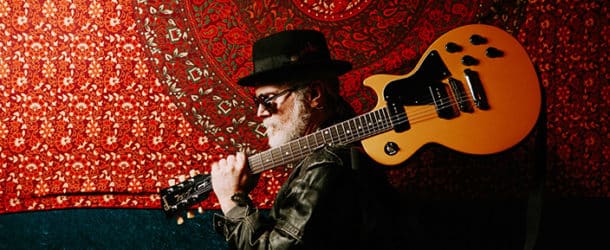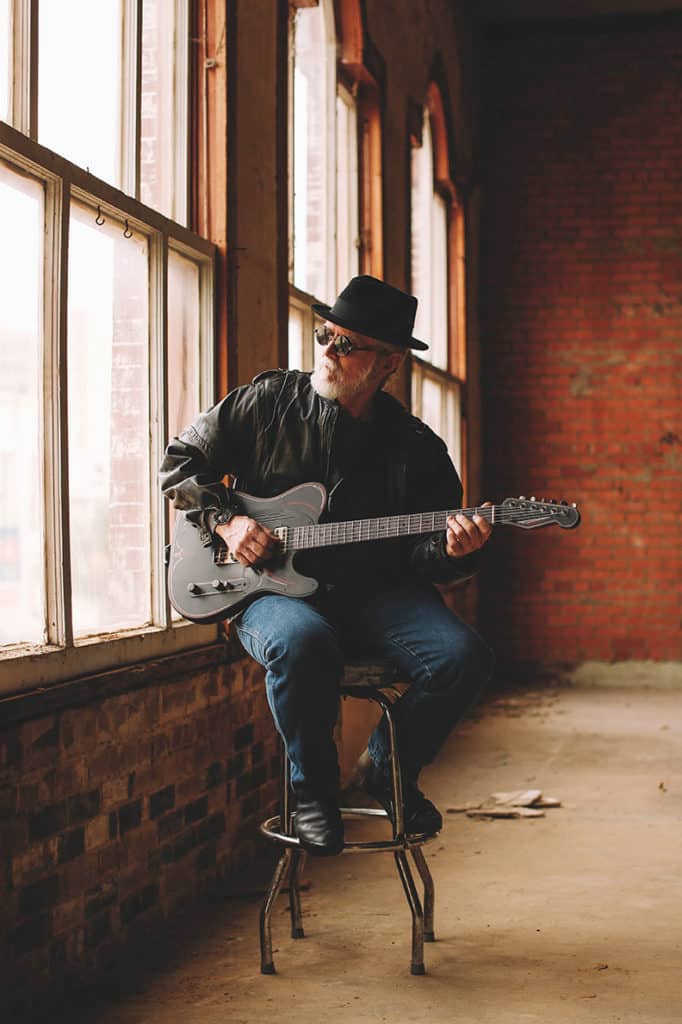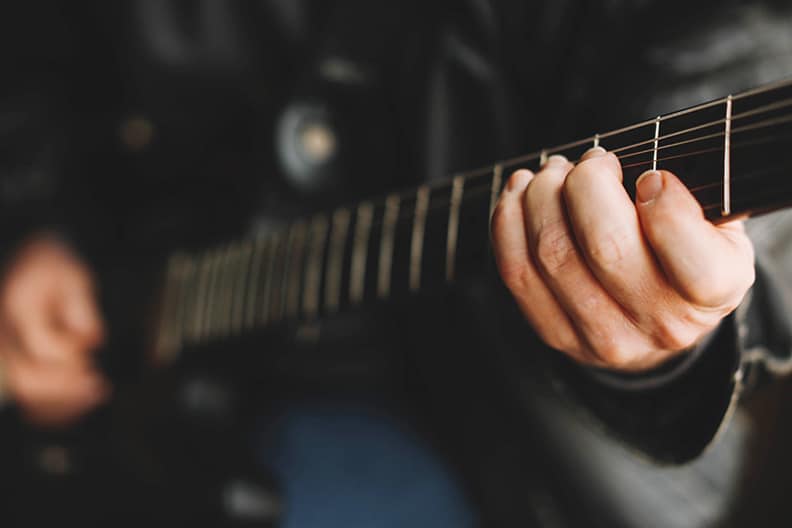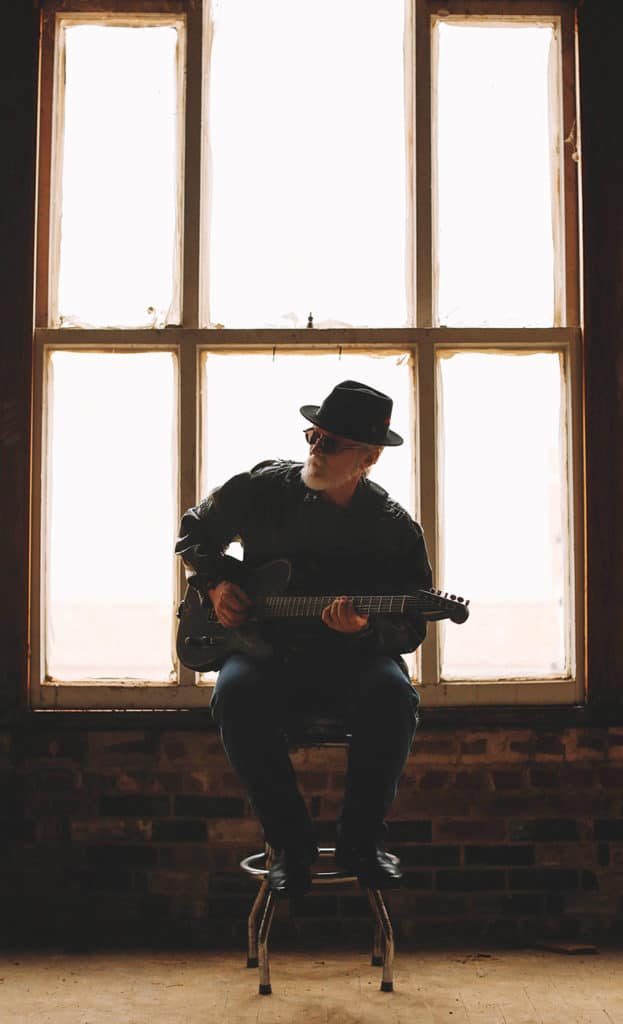Oakdale Native Steve Staples Has Struck Quite A Chord In The Music Industry
Story By Renn Loren
Photos by Chris Brennan
Stories.
Any rocker who has been around long enough to count will tell you that one of the greatest perks of a life in music — besides the music — are the stories. And, true to the tradition of all the great time- and road-tested troubadours, Steve Staples, owner of International Vintage Guitars, and guitarist extraordinaire with the Oakdale-based bands HollyRock and The Iceman Special, has a lot of good ones.
“I’m 65; there’re a lot of stories,” Staples proclaims enthusiastically in a slightly whiskey-graveled voice that carries a trace of Southwestern Louisiana regional dialect.
And indeed there are: such as the time ZZ Top’s Billy Gibbons (Staples’ first major artist customer) gave the entire staff at the expansive machine shop across the street from Staples’ store rides in his limo.
Gibbons was on his way from Houston to play in Biloxi in his limousine, and decided to drop by Staples’ shop, which was across the street from a huge machine shop that was open 24 hours a day to keep up with all the work on boat engines they had at the time. As the massive service bay doors were all open, all the guys at the shop noticed the black leather-clad Gibbons strolling into the guitar store from his limousine.
As Staples recounts in a series of false starts, “Billy and I are sittin’ there talkin’, and he’s playing the guitar, and we’re hanging out. The front door opens, and this guy just sticks his head in, and he goes; ‘Did I just see Billy Gibbons from ZZ Top walk in here?’ And Billy got up, and he goes; ‘Yeah, I’m here. Come on in.’ So (Gibbons) introduced himself to the guy, he shook the guy’s hand, and the guy says; ‘Man, I work in the machine shop over across the street. We’re all big fans of yours, and it’s just really great to see you,’ and Billy said, ‘Well, take me over there, and introduce me to everybody.’ So he goes out into his limousine, and gets a whole bunch of ZZ Top 8-by-10 glossy photographs, goes over to the shop, autographs all the photos, and gives ‘em all to everybody who wants one in that shop. Then he asks them if they’d like to go for a ride in his limousine. So these guys, two or three at a time, go for a ride in the limousine with Billy. I mean, that’s the kind of guy he is.”
There was also the time a few months later, when Gibbons called completely out of the blue, explaining; “Well, I’m in Alaska. I’m sitting in my hotel room, and there’s nobody to talk to, so I thought I’d call you.”
So Staples asked, “Well, what do you want to talk about? And he goes; ‘I don’t know, let’s just talk about something, I’m bored to death, there’s nobody up here to talk to but Eskimos and maids.’”
Staples responded by explaining that he could probably think of a thousand questions to ask Gibbons about himself, his music and his guitars, to which Gibbons exclaimed; “Well, fire away!” For the next two hours, Staples asked Gibbons every question he could think of.
Gibbons proceeded to speak in great depth, detail and candor about his whole philosophy about the guitars he uses, the amps he uses, the sound, how grateful and loyal he is to his fan base — to the point where he doesn’t want to vary his sound too much, so he uses the same guitar and amps he used on his first record on a minimum of two songs per record, so that his fanbase can still identify with the always classic ZZ Top sound.
“My fans support me,” Gibbons explains. “Every time I release an album, they buy two hundred thousand copies the first week.”
Woodstock opening act Richie Havens once stopped by the shop, and proceeded to give Staples a two-and-a-half-hour story session, jam and guitar lesson, demonstrating his exotic tunings and unique strumming techniques.
Jimmy Buffett showed up in the store while he was in town for a Saints playoff game, and told Staples his life story, bought a lot of gear, and talked about how he got in the music business. Buffett spoke about all the guitars he’d bought, sold and regretted selling, and just about life in general. There was the genuinely candid and revealing talk Staples had with Flea. The Red Hot Chili Peppers bassist had dropped in to buy his current guitar player a guitar as a birthday present, and ended up expounding for two or three hours. 
Flea told a story about the time he sat on a beach in Hawaii, and had an epiphany about the things that mattered in life, and decided that he was going to shape up and take a work-like approach to his music career, and start giving back for all that he’d been so fortunate to have received from the fates that be.
From such talks, Staples found that many of these major stars were mostly just very normal, humble people. They were all talented, and were in the right place at the right time. But they also seemed to have one universal trait that defined them: They all worked at it really, really hard, and were there when the breaks came, ready to deliver.
Staples was stricken most by the fact that these artists were still just like teenagers who are in love with guitars and playing — successful, yet still able to maintain a youthful exuberance about what they do.
In more recent years, Staples’ clients have included: Southern Culture on the Skids, Elvis Costello, the Doobie Brothers, Motley Crue, Pearl Jam (the whole band had a jam session in his shop), Marty Stuart, Coldplay and Bob Dylan.
Though perhaps mostly known for his world-renowned International Vintage Guitars shop in New Orleans, it was Staples’ interest in and love of music and guitars that made it all happen.
Originally from Louisiana, Staples’ parents were stationed in Oklahoma when he was born (his father was serving in the military). However, Steve and his mom moved back to her hometown of Oakdale for two years when his dad went off to the Korean War.
In Oakdale, Staples’ mother’s best friend was the Murry brothers’ (William and Charlie) grandma. Staples’ mother and the Murry’s grandmother had gone to kindergarten and grammar school together, and were roommates in college. The two families lived next to each other, and were so connected throughout the years that it was a tradition for them to spend Christmas together — even long after Steve had moved from Oakdale. It makes sense then that Staples fit right into the Murry brothers’ bands so easily years later.
Ruth Swann Cain, Staples’ grandmother, played piano both for the Methodist Church in Oakdale, and with a band that played all over the South. She also wrote music, and appeared on television.
Sitting on his grandma’s lap as she played the piano, Staples was singing melodies by age 2. Although his first introduction to the world of music had been the piano (his family had hoped he would learn to play the instrument), it would be the guitar that would thoroughly captivate, enthrall and thrill Staples, and become his lifelong obsessive passion.
Staples had fallen under the spell of the guitar from the first time he’d heard his neighbors — two brothers ages 11 and 12 — chiming away on their Fender electric guitars when he was just 4 or 5. Staples would spend every minute he could listening to those magically captivating sounds reverberating from those amp speakers. From that point on, Staples could not stop looking at guitars, listening to them, drawing them in the margins of his school assignments, and just generally being fascinated with them.
His obsession was such that he would look at every mail order catalog he could find, including Sears, Western Auto and Montgomery Ward, gazing at their guitar and instrument sections over and over.
Between 1952-56, Staples’ family frequently moved between Oakdale, Sulphur and Lake Charles.
“My fondest memories of Lake Charles are going to the Borden’s and Watson’s ice cream parlors on Ryan St. by the park near downtown,” he says. “I also remember that we went to the beach and swam in the Lake near the old bridge often. And I also remember drive-ins on Hwy. 90, where my parents would go. You could get mixed drinks delivered to your cars. There were a lot of clubs with neon signs, and there was actually a club where they had wrestling several nights a week. My Aunt Jean used to go to that place to watch the wrestling.”
Inspired and invigorated by the birth of Rock and Roll at the dawn of the 1950s, Staples found himself in a musically rich and encouraging environment. Waylon Jennings had a daily TV show then, and Staples was intrigued by the band, and the sounds of the guitars. Between the radio and record player, Staples’ musical knowledge and enthusiasm gained range and momentum as he absorbed every guitar record on which he could get his hands.
At age 9, Staples went into a record store and saw a record by Chet Atkins. The album had a cover photo with a recording studio, guitars and gadgets in the background. Staples was hopelessly hooked, and his appetite for all things guitar became insatiable.
At one point, when he was living in Lafayette, Staples was in the same class with Sonny Landreth. Staples would watch and listen, mesmerized, as Sonny and another guitar slinger traded riffs and chops. “Surf music was a significant influence,” Staples recalls fondly. The two would later reconnect many years later at a guitar festival in Switzerland. Their friendship is another whole story in itself.
When he was in fourth or fifth grade, living in New Orleans, Staples’ grammar school band friends tried to coax him over to brass instruments, to no avail, as the sounds of the Beatles on Staples’ transistor radio further fanned the flames of his obsession with guitars.
When he was 12, Staples’ parents got him his first acoustic guitar, with which Staples taught himself to play.
The next summer, on a trip to Alexandria with his grandmother, Staples spotted a Fender electric guitar in its case in the display window of a music store downtown. His grandmother noticed his longing gaze, and graciously bought it for him. Upon his return to New Orleans, his dad bought him an amp.
One of Staples’ classmates was a drummer for a local band called the Twilights, and asked Staples to fill in on a weekend gig. His parents gave him permission to take a day off from school to rehearse, and Staples learned 40 songs in a day to play the concert.
Staples gives lots of credit for his success to the overwhelming support of his parents, noting that his dad “never asked him to turn it down — ever! Not once in my whole life did my father ever come into my room to say, “’Turn that down!’ And I had some pretty big amplifiers in there at times, cranked all the way up. I was playing the Who and Jimi Hendrix, and all that stuff in the room, and my dad never ever once said ‘that’s too loud’ or ‘stop.’ Yeah, I don’t know how he could stand it, but he did.”
The Twilights evolved into the Gaunga Dyns, who had two regional hits in NOLA in the ‘60s, while the members were still in high school. They had two exceptionally talented singers who taught Staples to sing, harmonize and to further hone and develop his chops on the guitar.
The Gaunga Dyns also had an excellent manager, whose father was a record producer who produced the Neville Brothers.
The Gaunga Dyns played steadily throughout New Orleans nearly every weekend from the time Staples was 15 right through until the band broke up when he was 17. It was after studying business at LSU that Staples joined a group called Louisiana, and ended up in Memphis on a recording contract for a short while, until the band fell apart due to Rock and Roll’s most famous excesses taking their toll. Staples’ partner in the band went on to become a famous and successful songwriter in Nashville.
Staples moved back to Oakdale, where he joined, in his words, “a really good country and western band,” but then quit to regain focus before returning to NOLA, where he continued to play and record with various groups and individuals.
He decided to go back to school to study music at Loyola. That summer, he got a job working in a guitar shop, and realized that was where he wanted to be. While he was working at that guitar shop the owners took him along to a vintage guitar show in Houston to buy some guitars for the shop.
One look at that massive room filled with 10,000 vintage guitars was all it took for Staples to make his decision.
When he came upon an inheritance from his grandmother, he had to make a decision. Staples figured that school was too expensive, and decided to use his inheritance to open his own guitar shop, instead. With $35,000 worth of vintage guitars bought from a guitar show in Memphis, Staples opened up his shop. It turned out to be the right decision, the right place, and the right time: It was 1992, and every guitarist worth their strings came to buy some choice axes from Staples’ new shop, which was the only vintage guitar shop of its kind in Louisiana.
Soon, European musicians who were in New Orleans to make records began to hit International Vintage Guitars to get the instruments that would render the sounds they were after.
Freddy Koella, the guitarist for Willy DeVille and Zachary Richard, came into the shop two or three weeks after the shop had opened, explaining that his friend had two guitar stores in Paris, France, and would love to buy some of Staples’ guitars. He wanted to introduce Staples to that Paris friend, and asked Staples to call him right then and there. This friend’s name was James Trussart.
Staples took the phone, and was pleasantly surprised to hear that Koella’s friend spoke such clear English. Trussart asked what Staples had in his shop, and Staples started going down a list of his inventory. Trussart picked out 14 guitars on the spot, and asked if Staples could deliver them the next week in Paris. Staples found a way to get to Paris, where the two hit it off famously.
“It turned out that James and I were kindred spirits,” Staples says, “and James introduced me to a whole world of guitar players, collectors and clients. I’ve been over to his place in France 50 or 60 times since then. He lives in Los Angeles now, however. We still speak at least once a week. He’s one of my best friends.”
In addition to attending to the needs of his shop, Staples continued to play music with a variety of bands, including a nine- or 10-year run with a New Orleans blues band that won the Southern Blues Band Competition for House of Blues, and placed second or third at a competition at a House of Blues location in California.
Staples wanted to play more original music, and joined up with a band called One, which had a record contract but fell apart soon after. Then, about a year and a half ago, the Gaunga Dyns reunited to play at the Ponderosa Stomp. They fell apart again, however, due to a divorce.
By chance, Staples ran into one of the Murry brothers, and Murry suggested Staples join them for a jam. The Murrys felt that Staples fit right in, and Staples felt as if he had been with them the whole time.
They asked him to join both of their bands — the Americana-oriented HollyRock and the psychedelic-swamp-funk-blues outfit The Iceman Special — on a permanent basis. Of all the chapters in Staples’ Story, he feels that becoming a part of HollyRock and The Iceman Special with his lifelong friends the Murrys is one of the greatest and most enjoyable.
Dreams are funny things — elusive as wind, ephemeral as youth. Most dreams never come true. But dreams can come true for those who remain persistent; maintain their vision, their drive and their sense of wonder; and do the work.
Steve Staples may never have become a rock superstar; I don’t really think that was ever his aim or dream. But what he has become is so much more rewarding and substantive.
Thanks to International Vintage Guitars and his decades-long career as a musician in numerous bands, Staples is now very much a thoroughly intrinsic and integral part of the music scene of New Orleans. He is one of the real insiders — a member woven inextricably into the tight-knit musical community of the town. His clients have become friends — some of them very close through years of loyal patronage. When major artists or bands have a concert or recording session in New Orleans, the odds are that they’ll stop in to see Steve — as friends as much as customers.
The popularity and reputation of International Vintage Guitars as a place where one can get something very special that’s not found many other places continues. “You just never know who’ll stop by or drop in,” Staples reflects; “Just the other day, Bruno Mars bought three or four guitars from me … Joe Bonamassa recently purchased a bunch of guitars from me, too.”
Prized and rare stock varies as much as the clientele. A few of the most recent treasures are a 1966 Gibson Byrdland, a 1969 Fender Precision bass, a 1985 Gibson ES-175 — signed by BB King, a 1957 and a 1958 Gretsch, and a couple of really nice old Gibson and Fender amplifiers. It all changes from day to day.
“Sometimes, I’ll have a whole lot, and other days I’ll just have a smattering of things,” Staples explains, “because I’ve been in business for so long most of the stuff just walks straight through the front door, so I never know what’s gonna show up. Like yesterday, a guy comes in, and he said, ‘I have a friend who died, and I have 87 guitars. I need you to look at ‘em and let’s put ‘em in here and sell ‘em.’ So I’m gonna get about 60 of those, I think. Some of ‘em look pretty interesting to me, so we’ll see.”
Staples’ guitars of choice these days are a Gibson Les Paul Special, a James Trussart Custom Steelcaster and a Fender Jaguar. You can catch him channeling influences such as Chet Atkins, Steve Cropper, Jimi Hendrix, Dick Dale, Pete Townsend, Frank Zappa, David Gilmour and many others together with HollyRock or The Iceman Special at one of their many shows around the clubs in New Orleans, and throughout Louisiana. In Lake Charles, they play rather regularly at Luna Live, and in New Orleans, they often play the BMC (Balcony Music Club).
Still enthusiastic as ever, Staples muses, “Even now, when I get the new catalog from Sweetwater Sound, I immediately go to the guitar section and just gaze through it, and feel exactly the same way I did when I was 5.”
At age 65, Staples is living the dream he never even knew he had.
For more info, like International Vintage Guitars on Facebook or follow on Instagram @international_vintage_guitars.
For updates on HollyRock and The Iceman Special, like their pages on Facebook or follow on Instagram @holly_rock_ or @theicemanspecial






















Comments are closed.